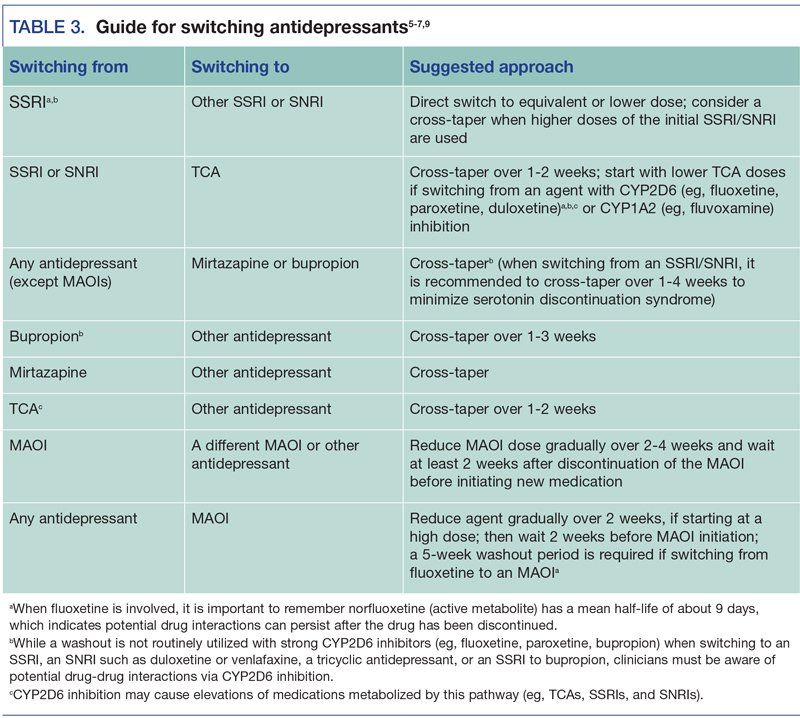Publication
Article
Psychiatric Times
Strategies and Solutions for Switching Antidepressant Medications
Author(s):
High treatment failure rates make it critical for prescribers to know how to safely and effectively switch antidepressants to ensure patient-treatment targets are met.
TABLE 1. Receptor activities and symptoms of abrupt discontinuation

TABLE 2. Advantages and disadvantages of various switching strategies

TABLE 3. Guide for switching antidepressants

One of the most common questions regarding antidepressants involves strategies for switching medications. This is not surprising, considering that results from the Sequenced Treatment Alternatives to Relieve Depression (STAR*D) trial drew attention to the high rates of initial treatment failure with first-line agents.1 More specifically, up to 65% of patients fail to achieve remission, and approximately half of all patients fail to achieve an adequate response from their first antidepressant medication trial. High treatment failure rates make it critical for prescribers to know how to safely and effectively switch antidepressants to ensure patient-treatment targets are met.
Understanding drug interactions
There is limited guidance on the efficacy and tolerability of various switch strategies, which makes it essential that providers have a strong foundation in the pharmacological properties of antidepressants to understand how pharmacokinetic and pharmacodynamic drug interactions affect patients during the switch period. For example, if a patient is completing a cross-taper to transition from an antidepressant that is a potent inhibitor of the cytochrome 450 metabolizing enzyme 2D6 (CYP2D6) (eg, bupropion, fluoxetine, paroxetine) to a new antidepressant metabolized primarily by CYP2D6, the serum concentration of the new medication will be elevated by the CYP2D6 inhibitor until the first medication is eliminated. This leads to slower titration of the second antidepressant.
An example of a pharmacodynamic drug interaction is the required 2-week antidepressant-free period after stopping an MAOI because of the risk of serotonin syndrome and hypertensive crisis from accumulated synaptic monoamines. Furthermore, providers must consider the severity of their patient’s mood symptoms and weigh it against the concern of adverse drug events. This may lead to a more rapid switch in the hope of realizing benefit from the new medication as quickly as possible.
Discontinuation syndrome
Discontinuation syndrome can occur upon abruptly stopping or rapidly lowering the dose of an antidepressant. Symptoms of discontinuation syndrome associated with various neurotransmitter and receptor systems are summarized in Table 1. Withdrawal phenomena need to be considered based on the pharmacology of how specific antidepressant medications affect serotonergic, adrenergic, histaminergic, and cholinergic activity. For example, TCAs have significant anticholinergic properties. Therefore, rapid withdrawal of these agents may precipitate cholinergic rebound, which can be associated with vomiting, nausea, headache, sweating, and muscle spasms. Cholinergic rebound can also apply to other antidepressants with anticholinergic properties that may be discontinued abruptly, such as paroxetine.2
Prescribers should focus on the pharmacology involved rather than on specific medication classes, as differences in pharmacology of drugs in the same class can be significant enough to induce disparate withdrawal syndromes. Another example of this might be abrupt discontinuation of SNRIs, which can result in serotonergic withdrawal in addition to increased gastrointestinal motility and urinary urgency due to loss of noradrenergic effects.
In the case of rapid discontinuation of mirtazapine, reports include hypertension, tachycardia, insomnia, and mild anticholinergic withdrawal.3 In the case of rapid discontinuation of MAOIs, potential symptoms may include flu-like symptoms, tachycardia, hypertension, restlessness, dysphoria, excitation, or psychosis.
The need to mitigate the risk of discontinuation syndrome is particularly important when directly switching antidepressants or rapidly decreasing the dose of the first antidepressant. Symptoms appear to be most common when antidepressants are taken for more than 6 weeks, especially those with short half-lives (eg, paroxetine, venlafaxine), or are discontinued abruptly.4 Fluoxetine has notably less propensity to cause discontinuation syndrome because of its long half-life of 4 to 16 days (when taking into consideration its active metabolite, norfluoxetine).5 Patients are more likely to experience discontinuation syndrome when they have had difficulty tolerating an antidepressant during the initial phase of treatment.5,6
Wilson and Lader6 describe various management approaches to minimize discontinuation syndrome symptoms when stopping or lowering the dose of antidepressants. In the case of severe withdrawal symptoms, they recommend restarting the antidepressant at the previous dose and initiating a slower taper. Although there was no consensus on best practice, many studies recommend at least 4 weeks of tapering the dose before discontinuing the medication. However, this is not always feasible in clinical practice. Ultimately, it is important for providers to monitor tolerability of the medication changes and to adjust the titration process according to individual reactions.
Switching strategies
Switching strategies that we discuss are listed in Table 2. The direct switch approach can be employed if the first agent was used for a short period (< 1 week) or when switching between some SSRIs, SNRIs, and TCAs (for more details, see Table 3). It is best to switch to an equivalent dose when possible. If the agent was used for a long period, or the patient was taking a high dose of medication, the cross-taper method is recommended. Cross-tapering is beneficial for individuals who are at high risk for relapsing from any improvement gained with the first medication, or are prone to discontinuation symptoms. As a general strategy, it is best to taper over at least 4 weeks if the agent was previously taken for 6 weeks or longer, and reduce the dose of the first medication by 25% per week.7 The first medication can be reduced at a slower rate if discontinuation symptoms were experienced previously, or if the patient is not tolerating the initial switching strategy.
When completing a cross-taper, it is also important to be aware of available dose formulations to avoid instructing the patient to take doses that are not feasible during the taper. Both the direct switch and cross-tapering methods have increased risk of drug-drug interactions when compared with a conservative switch strategy that utilizes a washout period of no medication. In practice, this approach is rarely attempted, with the exception of discontinuing an MAOI. Fluoxetine also has specific recommendations because of its long half-life, as detailed in Table 3. Although not comprehensive, Table 3 may be used as a general guide for switching between antidepressant medications.
Conclusion
There are many patient-specific factors that affect how rapidly an antidepressant is switched or withdrawn when medication changes are made; practitioners must treat patients on an individualized basis. Factors such as withdrawal from the old antidepressant, discontinuation syndrome, or washout periods can prolong the achievement of remission, and successful switching may take several weeks to months. This may seem overwhelming to an already at-risk population, since it leads to further-protracted treatment response.
Clinicians should strongly encourage patients to closely monitor for adverse effects when switching agents. Milder adverse events will dissipate with time, but severe, life-threatening events require immediate medical attention. Each switch strategy must be tailored to the patient and realistic expectations given to help optimize treatment success.
Disclosures:
Ms. Soreide is a third-year pharmacy student at the University of Michigan College of Pharmacy. Dr. Ward is Clinical Assistant Professor, the University of Michigan College of Pharmacy, and Clinical Pharmacist in Psychiatry, Michigan Medicine, Ann Arbor. Dr. Bostwick is Associate Chair and Clinical Associate Professor, Department of Clinical Pharmacy, University of Michigan College of Pharmacy and Clinical Pharmacist in Psychiatry, Michigan Medicine, Ann Arbor.
References:
1. Rush AJ, Trivedi MH, Wisniewski SR, et al. Bupropion-SR, sertraline, or venlafaxine-XR after failure of SSRIs for depression. N Engl J Med. 2006;354:1231-1242.
2. Bhanji NH, Chouinard G, Kolivakis T, Margolese HC. Persistent tardive rebound panic disorder, rebound anxiety and insomnia following paroxetine withdrawal: a review of rebound-withdrawal phenomena. Can J Clin Pharmacol. 2006;13:e69-e74.
3. Howland RH. Potential adverse effects of discontinuing psychotropic drugs: part 2: antidepressant drugs. J Psychosoc Nurs Ment Health Serv. 2010;48: 9-12.
4. Warner CH, Bobo W, Warner C, et al. Antidepressant discontinuation syndrome. Am Fam Physician. 2006;74:449-456.
5. Keks N, Hope J, Keogh S. Switching and stopping antidepressants. Aust Prescr. 2016;39:76-83.
6. Wilson E, Lader M. A review of the management of antidepressant discontinuation symptoms. Ther Adv Psychopharmacol. 2015;5:357-368.
7. Ogle NK, Akkerman SR. Guidance for the discontinuation or switching of antidepressant therapies in adults. J Pharm Pract. 2013;26:389-396.
8. Howland RH. Potential adverse effects of discontinuing psychotropic drugs. Part 1: Adrenergic, cholinergic, and histamine drugs. J Psychosoc Nurs Ment Health Serv. 2010;48:11-14.
9. Hirsch M, Birnbaum RJ. Switching antidepressant medications in adults. UpToDate. https://www.uptodate.com/contents/switching-antidepressant-medications-in-adults. Accessed November 10, 2017.







